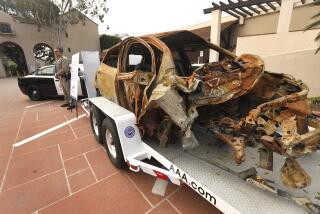Little monster of all hazards
- Share via
Millions of cellphones, billions of hamburgers and untold tubes of lipstick lurk in the hands of motorists, threatening a fatal distraction.
But something else inside many cars is an equal or even greater influence over the mind of a driver, something as innocent as a little child.
Ever since cars were invented, long before cellphones or fast food drive-thru lanes, parents have been driving with their kids in the rear seat and have been turning around to tell them to “settle down!”
Unfortunately, it’s no joke.
Burbank resident Frankie Glass clearly remembers the day two years ago when the driver of an oncoming vehicle was dealing with his three kids in the car. The driver first veered out of the way of a car directly in front of Glass and then into Glass’ lane, making an almost direct head-on collision with Glass’ car.
The shopping trip that day ended tragically, seriously injuring Glass’ 89-year-old mother. After a week in intensive care, she died.
“You can’t imagine how something in a split second can change everything in your life,” Glass said. “People don’t understand cars are a dangerous weapon. They kill people.”
Last month, California enacted a new law that would impose fines on drivers who use hand-held cellphones, the result of public outrage over drivers who endlessly chat away and exhibit bad driving much of the time.
The distraction caused by children is likely at least as serious a problem as cellphones. Unlike cellphones, it is not a problem that lends itself to public outrage or legislation.
It is not something that rallies people like drunk driving. The police can’t use radar to determine when to pull over a driver because his or her mind has been twisted into knots by unruly kids.
Proponents of cellphone restrictions cited data gathered by the California Highway Patrol showing that in 2005, cellphone use was blamed for seven fatalities. In six other deaths, a radio or television was in use in the car. And fussy children were blamed for distracting drivers before crashes that took the lives of six people.
All of these statistics undoubtedly underestimate the true scope of the problem. Few drivers admit that they caused an accident because of distraction.
How distracting are kids? In my experience, I can remember times behind the wheel when I could barely focus on driving tasks while trying to maintain some degree of order in the car.
I recall my son’s 8th birthday, driving five 8-year-old boys to the bowling alley. I remember being at the Tijuana border, stuck in the inspection lines for a full hour with a crying 16-month-old daughter. I can recall driving while one kid relentlessly kicked the back of my seat, even after being told 10 times to stop.
As my children grew older, I began to realize it was better to pull over and deal with discipline problems. But in hindsight, as a young parent, I was completely unprepared to know how much of a mind-bending experience unruly kids can be inside a car.
Of course, many parents say that they have taught their children good manners and respect for the driver. I thought so too and found out that order can still break down.
Joan Claybrook, former head of the National Highway Traffic Safety Administration and now president of the advocacy group Public Citizen, says driver distraction from all causes, including kids, is an underestimated problem.
“It is huge,” Claybrook said. “Distracted drivers are a major issue. And people are distracted for many reasons.”
When Claybrook was growing up, her parents had a simple rule for short trips. If you didn’t behave in the car, you ended up walking.
The most important way to control kids these days is to make sure they are wearing seat belts, Claybrook said. “When kids have their seat belts on, they are less likely to be rowdy.”
That’s better advice than I see coming from the major government safety groups. NHTSA has a School Bus Safety Program. In a section on its website called “Tips for Maintaining a Good Attitude,” the agency suggests doing this before starting your car: “Close your eyes; breathe evenly; think about the tension draining from your body. Repeat ‘I’m calm.’ ”
You might as well add, “Put the car in park and then jump out the door.”
The California Department of Motor Vehicles does not give much better advice. In its handbook for commercial drivers, it suggests letting off “unruly passengers” at the earliest opportunity. In a section on “Prohibited Practices,” the DMV advises, “Do not engage in unnecessary conversation with passengers or any other distracting activity while driving.”
The problem is that our system of auto safety is largely reactive, meaning it responds to advocacy groups that generally blame fatal accidents on corporations or on a driver’s illegal behavior -- auto manufacturers and alcohol being the two most prominent examples.
The federal government is trying to get a better handle on driver distraction issues, but it is late in coming. State governments should do a much better job of training new drivers to understand they cannot discipline kids from behind the wheel.
More to Read
Sign up for Essential California
The most important California stories and recommendations in your inbox every morning.
You may occasionally receive promotional content from the Los Angeles Times.














